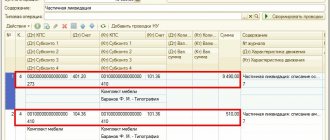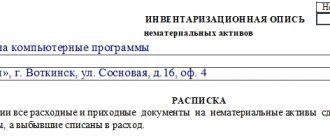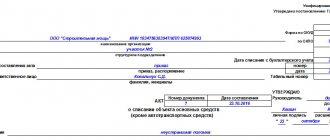Is it necessary to conduct an OS inventory?
Companies must regularly check the actual availability of their fixed assets.
Cases of mandatory inventory are specified in the Regulations on accounting and reporting in the Russian Federation (hereinafter referred to as the Regulations), approved. by order of the Ministry of Finance dated July 29, 1998 No. 34n (clause 27), and Methodological Instructions for Inventory (hereinafter referred to as the Methodological Instructions), approved. by order of the Ministry of Finance dated June 13, 1995 No. 49 (clause 1.5). There are few such cases, and they are associated with the company’s plans to sell property or rent it out. Inventory is also needed after a fire and other extreme situations, before drawing up a liquidation balance sheet, etc. The most common situation is carrying out an inventory before drawing up an annual balance sheet. If the company's statements are subject to mandatory audit, then without carrying out an inventory procedure it will be problematic to confirm the accuracy of the balance sheet (namely, it contains information about the company's property status).
For information about who is required to have an external audit, read the material “What are the features of audited financial control? ”
The procedure for filling out an inventory form with an example
The page is completed in two steps. First, the header and all items of the goods are entered, and then, during the assessment of the quantity and condition of the items, availability is indicated. Afterwards, the signatures of the financially responsible person (MRP) and a member of the commission are affixed.
Let's start with the header. Not all fields that are presented there are required. For example, the type of activity, also known as the OKONKH code, is indicated as the main detail, although in a number of other documents it is omitted. And the “Type of operation” column is often empty, since not all organizations officially use the code system. You can also not write anything in the “structural unit” line. Please note that in places where there is nothing to indicate, there is no need to put dashes or other signs of missing data; it is enough to leave it blank.
The hat was the first step. Here you should also indicate all the information about the document on the basis of which a scheduled or extraordinary inspection is carried out. This can be ordered by the manager. Most often the paper looks like this:
Thus, already at the preliminary stage the following are known:
- the date of the;
- initials and positions of commission members;
- what exactly is subject to inventory.
Therefore, this information, as well as the order number, can be entered in advance into the INV-3 report.
The second step is confirmation that the valuables and funds entrusted to its storage were either capitalized (and confirmations and checks are provided for this) or written off - this fact is also verified. You must be prepared to provide explanatory reasons for the write-off. For example, expired products or goods damaged during transportation. The MOL puts its signature under the relevant paragraph even before the start of the entire procedure.
Inventory list of fixed assets: registration procedure
To properly conduct an inventory, it is necessary to create a commission and issue an order. The procedure itself is simple, but requires knowledge of individual regulations.
Thus, the commission can check the actual availability of fixed assets only in the presence of financially responsible persons (clause 2.8 of the Methodological Instructions) - otherwise, the inventory results may be invalidated. Monitoring the presence of OS can be carried out once every 3 years (clause 1.5 of the Guidelines, clause 27 of the Regulations).
Find out how to properly conduct an inventory of fixed assets at ConsultantPlus. If you don't have access to the system, get a free trial online.
The results of the inventory need to be documented - for this, a document such as an inventory list is usually used. You can download the unified form for the inventory list of fixed assets INV-1, approved by Decree of the State Statistics Committee of Russia dated August 18, 1998 No. 88, on our website.
Also, an inventory list of fixed assets can be developed by the company independently - it is not necessary to use standardized forms now.
Read more about this in the article “Primary document: requirements for the form and the consequences of its violation .
The inventory list of form INV-1 is compiled in 2 copies for each location where the OS is stored. It contains information about the actual availability of objects; if an object reflected in accounting is missing, data on it is also included in the inventory. An inventory list of fixed assets in the INV-1 form must be compiled separately for fixed assets for production and non-production purposes, as well as for own and leased property. If the company has leased fixed assets, then an inventory list for them is also prepared for the lessor.
Also find out the nuances of conducting an inventory of real estate, both listed as fixed assets and those that do not belong to fixed assets. To do this, study the ready-made solution prepared by ConsultantPlus experts. If you do not have access to the K+ system, get temporary demo access for free.
Documentation, stages
First you need to determine how many objects require the procedure, and in what time frame the event must be carried out. At the same stage, a special commission is created.
The decision is formalized by one or more orders on behalf of the head of the enterprise. And it is the director who does everything possible to create appropriate conditions, with the exception of situations where inventory is a mandatory procedure carried out forcibly.
There is no single form in the legislation by which an inventory could be completed. Therefore, in practice, a document approved by government decree No. 241 of 1989 is often chosen. But the enterprise can develop its own document, which takes into account the features of certain processes, and letterheads, which provide standard data.
Inventories are created for each individual object or for groups. Such rules apply to any assets, current or non-current.
It becomes mandatory to indicate such data on an object as:
- useful life
- depreciation amount
- original or revalued cost
- year of issue
- serial number, if available
- manufacturer
- inventory number
If there are precious metals, then information about them is included in a separate group. The main thing is that the company takes into account the rules regarding their recording and storage.
When gemstones go into equipment and tools, they are inspected at the same time as the main object itself.
A separate inventory is compiled of the funds that were leased. Copies of inventories are provided to the owners of such objects.
It is necessary to have information about when fixed assets are deregistered or from direct operation, and about the time when the procedure itself began and ended. In case of movement of fixed assets during inventory, it is impossible to do without document numbering. If the commission discovers objects that were not previously mentioned, then appropriate amendments are made.
Results
The owner is primarily interested in conducting an inventory of property: both the property is under control and the reporting is reliable.
An inventory list, which can be compiled according to the unified INV-1 form, helps to correctly document the results of the inventory of fixed assets. The procedure for filling out and a sample inventory of fixed assets is discussed in detail in this article. You can find more complete information on the topic in ConsultantPlus. Free trial access to the system for 2 days.
Business Solutions
- shops clothing, shoes, groceries, toys, cosmetics, appliances Read more
- warehouses
material, in-production, sales and transport organizations Read more
- marking
tobacco, shoes, consumer goods, medicines Read more
- production
meat, procurement, machining, assembly and installation Read more
- rfid
radio frequency identification of inventory items More details
- egais
automation of accounting operations with alcoholic beverages Read more
Government institutions and pharmacies stand separately. For them, this process is more complicated, because any error in reporting or significant shortfall can be considered as negligence, abuse of authority, or even waste of the budget, which can result in not only dismissal and a fine, but also criminal prosecution and even imprisonment.
In the process of this activity, an inventory list is drawn up - this is paper designed to record inventory items, their quantity, and quality. Usually it is drawn up in two identical copies in the presence of the responsible employee and the commission members. All listed persons put their signatures upon completion of the inspection. As a result, one completed form is transferred to the accounting department for storage, and the second remains with the responsible person.
To carry out all the seemingly simple manipulations listed above, you must first obtain a signed decree on conducting an inventory in the INV-22 form. This reporting not only warns of the approaching inspection and authorizes it, but also acts as an important act that is provided as evidence. Therefore, it is kept by the accountant for 5 years.
Why do you need an inventory report?
The state obliges enterprises to regularly conduct an inventory of assets and liabilities - this is enshrined in Art. 11 Federal Law No. 402 “On Accounting”. However, the law does not provide for penalties for non-compliance. Therefore, some individual entrepreneurs and organizations do not pay due attention to inventory. But in vain! The event allows you to find out how many goods you have, what condition they are in, and whether there are any losses.
An inventory report is needed to control inventory, cash, intangible assets, as well as debts to counterparties or creditors. With the help of a check, you can find out whether the actual presence of valuables corresponds to the quantity recorded in the accounting documents.
How to fill it out correctly
There are several recommendations and requirements for how to correctly fill out an inventory of inventory items:
- It is prohibited to make changes without the presence of the MOL;
- the committee must always contain the same persons who were announced by the order;
- information is recorded only after actual detection of the actual presence of inventory items (not from the words of anyone).
All results are recorded on paper. In this case, both presence and deficiency are recorded. Based on this, acts will be drawn up that confirm the excess or shortage. If this is detected, then an internal investigation should be carried out or everything should be written off in the “Expenses” column of accounting. Orders should also be signed for all this.
In addition, it is necessary to indicate:
- the cost of a commodity unit - this determines, for example, what amount will be deducted from the employee responsible for this;
- product code - this makes it easier to carry out all procedures according to the article;
- condition, quality.
The latter is important because a number of products are defective or broken. They are usually sold at a deep discount, often to the detriment of the company, and sometimes this is the basis for a write-off. Thus, even damaged items must be recorded on the list.
If there are free columns in the form (in the table), then they are crossed out across the entire width of the space with the letter Z, this is necessary so as not to enter anything unnecessary there.
As mentioned earlier, a form in the INV-3 form is taken. But if the corporation has non-financial assets, then they should be entered in form 0504087. A clean sample looks like this:
In fact, it contains the same fields as those presented above, but the cost of accounting units is not taken into account.
Entering information into paper on fixed assets (Fixed Assets)
This process is carried out at least once every three years. In this case, the INV-1 form is used, which in content is practically indistinguishable from the one presented above. Its design follows the above order. Here the following columns will be indicated:
- real estate;
- cars and other vehicles, including agricultural machines;
- equipment and electrical engineering;
- household equipment;
- adult draft animals;
- special tools and other means that are essential to ensure the activities of the enterprise.









